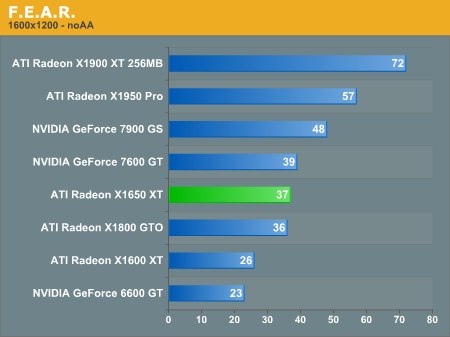Introducing the Radeon X1650 XT: A New Mainstream GPU from ATI
by Josh Venning on October 30, 2006 6:00 AM EST- Posted in
- GPUs
F.E.A.R. Performance
F.E.A.R. is another one of our standard benchmarks for testing GPU performance. When it was first released, it was the most graphically intensive first-person shooter (or of just about any genre for that matter) on the market. We also found that the game had a few quirks, notably a poorly implemented "soft shadows" effect option that caused a big performance hit without really working graphically at all.
The test we use is the built in performance analysis test that the developers conveniently included in the performance section of the game menu. This is basically a flythrough of a few different rooms consisting of a gunfight, a pool of rippling water and an explosion with flames at the end. We tested F.E.A.R. with the highest quality settings enabled, naturally with the exception of soft shadows which were disabled.


With F.E.A.R. the 7600 GT goes back to getting a few FPS better than the X1650 XT across all resolutions. Around 25 FPS and above is what we consider playable for this game, and most of the cards here achieve this up to 1600x1200. The 6600 GT doesn't quite manage this resolution, and the X1800 GTO is borderline playable. These happen to be cards that have been on their way out for a while now, so this isn't such a surprise.
F.E.A.R. is another one of our standard benchmarks for testing GPU performance. When it was first released, it was the most graphically intensive first-person shooter (or of just about any genre for that matter) on the market. We also found that the game had a few quirks, notably a poorly implemented "soft shadows" effect option that caused a big performance hit without really working graphically at all.
The test we use is the built in performance analysis test that the developers conveniently included in the performance section of the game menu. This is basically a flythrough of a few different rooms consisting of a gunfight, a pool of rippling water and an explosion with flames at the end. We tested F.E.A.R. with the highest quality settings enabled, naturally with the exception of soft shadows which were disabled.


With F.E.A.R. the 7600 GT goes back to getting a few FPS better than the X1650 XT across all resolutions. Around 25 FPS and above is what we consider playable for this game, and most of the cards here achieve this up to 1600x1200. The 6600 GT doesn't quite manage this resolution, and the X1800 GTO is borderline playable. These happen to be cards that have been on their way out for a while now, so this isn't such a surprise.










33 Comments
View All Comments
LuxFestinus - Monday, October 30, 2006 - link
One nice thing about the X1650 XT is that is doesn't require an external power connection. The second "is" should be "it" please. Thank you.Josh Venning - Monday, October 30, 2006 - link
It's been fixed. Thankstrabpukcip - Monday, October 30, 2006 - link
I think they meant the 7600GT doesn't require an external power connector.
I sure remember hooking up the power connector for my little brother's 7900GS less than five metres from me, being derived from a crippled 7900GT and all.
And as for you you American dotted underline spellchecker. I spell it metres NOT meters where I come from ;). (It even underlined "spellchecker", the irony).
bldckstark - Monday, October 30, 2006 - link
What colour was the underline?DerekWilson - Monday, October 30, 2006 - link
lolJarredWalton - Monday, October 30, 2006 - link
Back to the original comment, this has been corrected. Unless Josh knows something I don't, all of the 7900 GS cards I can find require a PCIe power connector. 7600 GT does not, however. Odd, considering power draws are about the same.BigLan - Monday, October 30, 2006 - link
What's the avivo performance of the x1650xt? Can it handle acceleration of 1080i/p stuff, or is it limited to 720p like it's predecessor? If it can only do 720p it's taking a huge hit against the 7600gt which has full purevideo compatibility (and is the current darling of the htpc crowd.)Also, I haven't heard anything about gpu accelerated transcoding in a while. Any chance of getting an anandtech article about it using non-beta versions?
blckgrffn - Monday, October 30, 2006 - link
An incomplete specifications table, assertions like "it has twice the pixel pipelines, 12 to 24 which will fix the performance issues" when really the x16xx family was plagued by a fill rate comparable to a 9600XT.Don't take this personal Josh - but Anandtech is supposed to have the definitive review, not simply an adequate one.
Nat
DerekWilson - Monday, October 30, 2006 - link
We had trouble tracking down the # of vertex and color/z pipes -- we didn't want to comment on any fill rate differences until we could confirm our suspicions -- raster pipes have doubled, and this definitely helps at higher resolutions and with AA or stencil shadows, etc...But doubling the pixel pipes does allow them to get a big boost in performance without upping the clock speed in more modern games (like oblivion) where fill rate wasnt as large an issue.
Sorry for the gap in the article -- it has been updated and a paragraph has been added after our charts to explain the impact of raster pipes. In the future, we'll be sure to get ahold of the data we need in a more timely fashion.
Derek Wilson
blckgrffn - Tuesday, October 31, 2006 - link
Thanks!Anandtech is my homepage, and will continue to be for some time. Really, I think we all just want to see this site be the best that it can be.
Nat